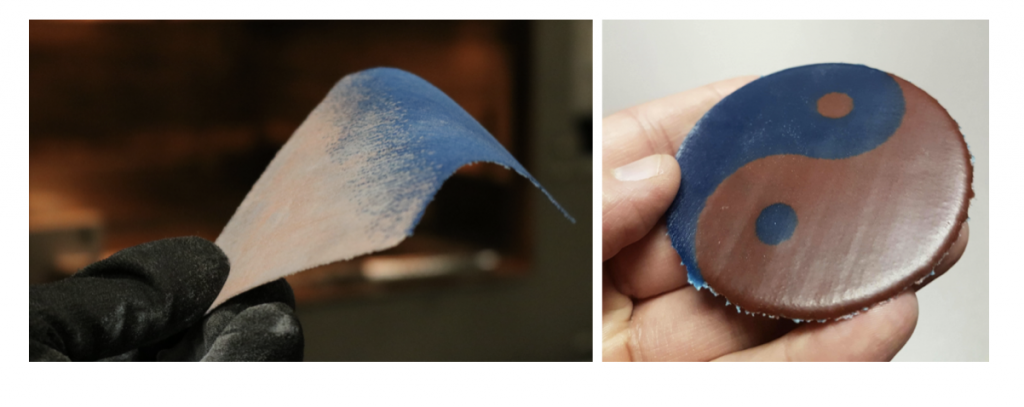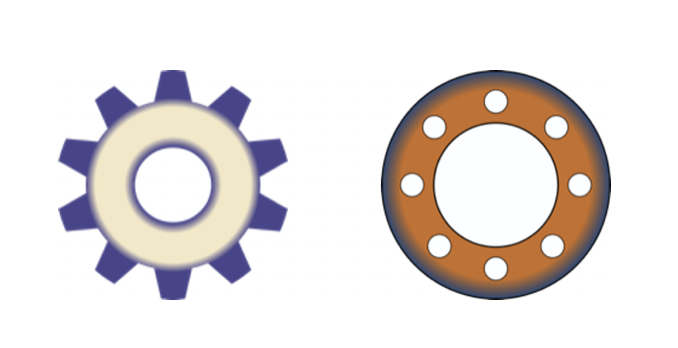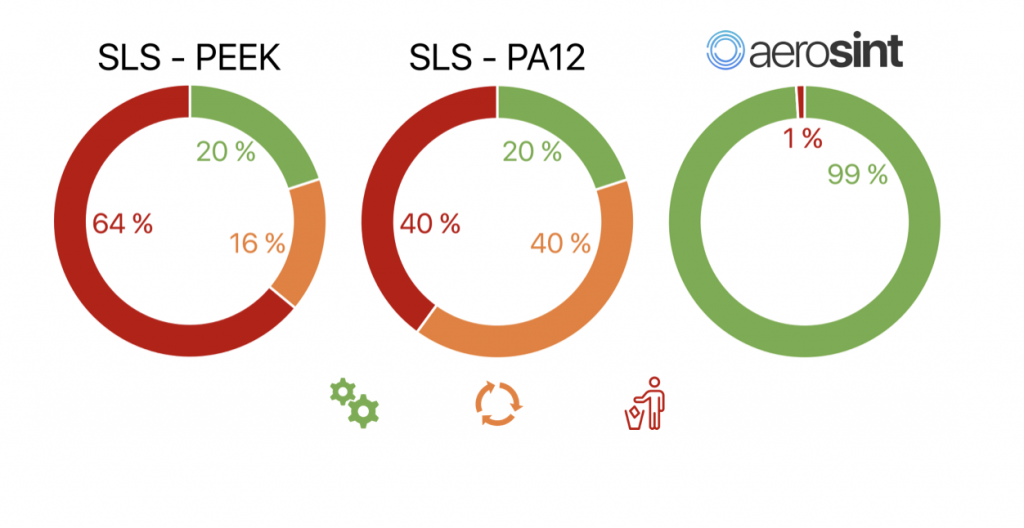Aerosint and Aconity3D develop multi-material metal 3D printer
Aerosint, Vectoflow, and Fraunhofer IGCV receive €750,000 to develop 3D printed airflow sensors
Aerosint and InfraTrac Extending Chemical Tagging in Parts 3D Printed with Powder Bed Fusion
 I can’t think of a single person who likes getting the automated reminder that it’s time to change their password, which includes the many instructions on what does and doesn’t make a good one – capital letters, numbers, spaces vs. no spaces, no repeats, etc. etc. But it’s a necessary evil if we want to keep our data safe, which is why many companies, and even apps, have made these reminders standard procedure. So why aren’t we doing the same when it comes to our 3D printed products?
I can’t think of a single person who likes getting the automated reminder that it’s time to change their password, which includes the many instructions on what does and doesn’t make a good one – capital letters, numbers, spaces vs. no spaces, no repeats, etc. etc. But it’s a necessary evil if we want to keep our data safe, which is why many companies, and even apps, have made these reminders standard procedure. So why aren’t we doing the same when it comes to our 3D printed products?
There are plenty of options to make our prints secure and easy to authenticate, such as QR codes, watermarks, serial numbers, RFID tags, and even holograms. But while marking parts is standard for some, it’s not mainstream yet, and as 3D printing continues to scale, security will become more important, not less.
 That’s why Belgian company Aerosint, which developed a selective powder deposition system to replace the single-material recoater in laser powder bed fusion (LPBF) processes, has teamed up with Maryland-based InfraTrac to extend chemical security into multi-powder deposition 3D printing through covert part tagging.
That’s why Belgian company Aerosint, which developed a selective powder deposition system to replace the single-material recoater in laser powder bed fusion (LPBF) processes, has teamed up with Maryland-based InfraTrac to extend chemical security into multi-powder deposition 3D printing through covert part tagging.
According to an Aerosint press release, “…the ability for anyone to create end-use parts enables bad actors as well as helpful new outsourcing players. Some of the people 3D-printing aircraft and auto parts are not going to be licensed, careful, high-quality suppliers, and new approaches to protection will be required.
“In this new model, a digital file conveys the ability to create a product. Software protections and digital rights management are necessary to protect the intellectual property in that file. However, none of those digital protections are going to keep us safe from 3D-printed counterfeit parts and products: once the print is complete, its digital safeguards lose their power. Anti-counterfeiting for additive manufacturing needs to be integral to the final printed product.”

Parts can be tested for the presence of site-specific chemical taggants using a small, handheld spectrometer like those in the Spectral Engines NIROne series (left). In the right panel, an ULTEM sample (lit orange) containing an InfraTrac taggant is assayed. Penny for scale. [Image: Aerosint]
InfraTrac has an award-winning method for anti-counterfeiting in 3D printed parts – it adds a taggant (compatible chemical marker) during printing in a small, covert, subsurface spot. With instant field detection, the company’s tagging model provides chemical security to 3D printed parts. But until now, this was only limited to one material, making it unavailable for powder bed 3D printing, which is an important process for scalable industrial applications. But by teaming up with Aerosint, InfraTrac can now extend its model even further.
“Complexity is the enemy of security: difficult procedures invite work-arounds,” the Aerosint press release states. “That’s what makes us reuse passwords even when we know we shouldn’t. Security procedures that align with existing processes are most likely to be adopted, and less likely to be circumvented. Applying taggant or codes should be part of the standard print or manufacturing workflow, not an add-on. Detection should take seconds, with inexpensive, portable, off-the-shelf equipment.”
 LPBF 3D printing, like SLM and SLS, use selective fusion of powdered material spread in layers across a build surface, but neither of these two popular methods can place multiple powders within a layer at specific locations. With control at the voxel level, it’s possible to precisely put two or more powdered materials in one layer…and this is exactly the kind of selective powder deposition system that Aerosint is working on.
LPBF 3D printing, like SLM and SLS, use selective fusion of powdered material spread in layers across a build surface, but neither of these two popular methods can place multiple powders within a layer at specific locations. With control at the voxel level, it’s possible to precisely put two or more powdered materials in one layer…and this is exactly the kind of selective powder deposition system that Aerosint is working on.
In its new collaboration with InfraTrac, Aerosint is 3D printing simple demonstrator parts from both polymer and metal, which include fingerprinting sites that are based on InfraTrac’s powder formulation. These components, printed on either an SLM or SLS system that is equipped with the special recoater, have embedded materials at specific sites that can be traced by InfraTrac; then, the parts will be tested and verified. Because InfraTrac can make its taggant materials appear identical to the bulk material of the 3D printed part, it’s just about impossible to counterfeit them.
Thanks to the partnership between Aerosint and InfraTrac, users in industries that require the strictest quality control can confidently ensure simple, scalable sourcing authenticity of their parts.
What do you think? Discuss this story and other 3D printing topics at 3DPrintBoard.com or share your thoughts in the Facebook comments below.
Aerosint and InfraTrac partner to prevent part counterfeiting in powder bed additive manufacturing
Formnext invites applicants for the 2019 3D printing Start-up Challenge
Solvay collaborates with Aerosint to develop high-performance polymers for SLS multi-material 3D printing
Aerosint and Aconity3D collaborate to accelerate Laser Powder Bed Fusion additive manufacturing
Q&A with Aerosint – Formnext 2018 startup challenge winner
Interview With Kevin Eckes of Selective Powder Deposition Firm Aerosint
Most new startups in 3D printing are rather boring. There’s lots of whizzbang but very little fundamental innovation. Most of them are looking to score not looking to improve 3D printing as a whole. Aerosint may very well be one of the few startups that could bring true innovation to 3D printing. The startup is looking to change how powder bed systems recoat themselves, how they deal with supports and in the process open up a whole host of new materials and applications while also reducing the cost of parts. We interviewed Kevin Eckes of Aerosint to find out more about this potentially very exciting startup.
What is Aerosint?
Aerosint is a company founded in 2016 on the idea that selective powder deposition will make additive manufacturing more capable, scalable, and less expensive. We have developed a mechanical system that replaces the normal powder recoater in SLS/SLM systems so that multiple powders can be deposited in a single layer with spatial selectivity.
What challenges do you hope to solve for people?
We believe our technology will allow for the scaled production of advanced parts that are topology-, material-, and cost-optimized. Most powder bed fusion AM techniques currently are focused primarily on geometric capability, far less on part cost, and almost not at all on efficiency gains through the use of multiple materials. In short, we want to help additive manufacturing live up to its hype and be able to build the best parts possible at the lowest cost.
How does your technology work?
The system we have developed deposits small ‘voxels’ of powder in a line-by-line fashion from rotating drums that pass over a build platform in an SLS or SLM machine. Unlike the single-material recoating process used in SLS/SLM/MJF/binder-jetting processes, in using our system one has full three-dimensional control over powder material placement, which is required for building multi-material parts.
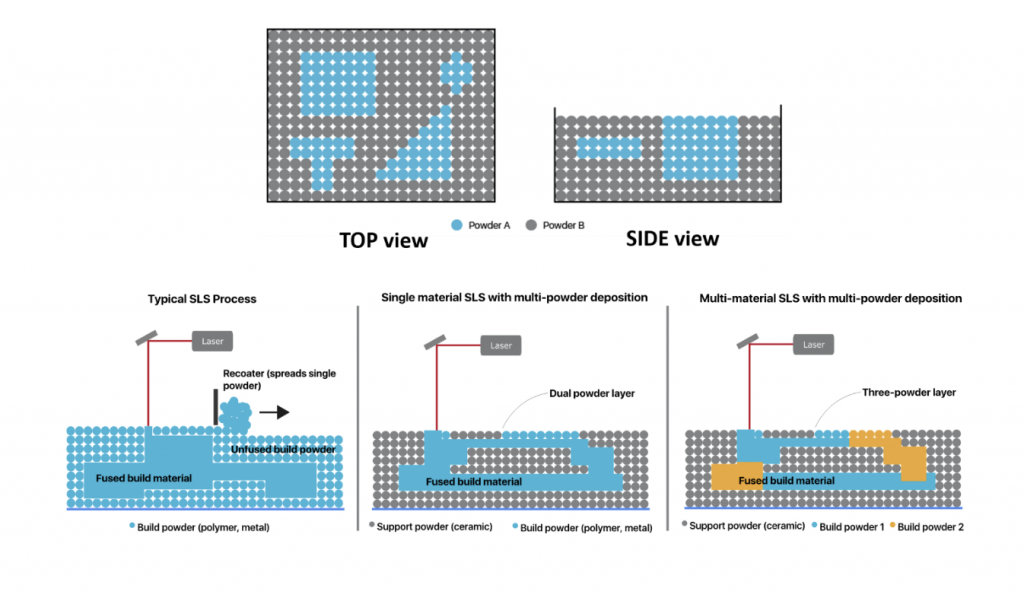
Why is the rotating drum essential?
It’s the most efficient geometry for the application. With a rotating drum the only limits of the X and Z dimensions are the size of the machine enclosing the Aerosint recoater system. The length of the rotating drum (i.e. axial dimension) limits the Y-dimension of the build.
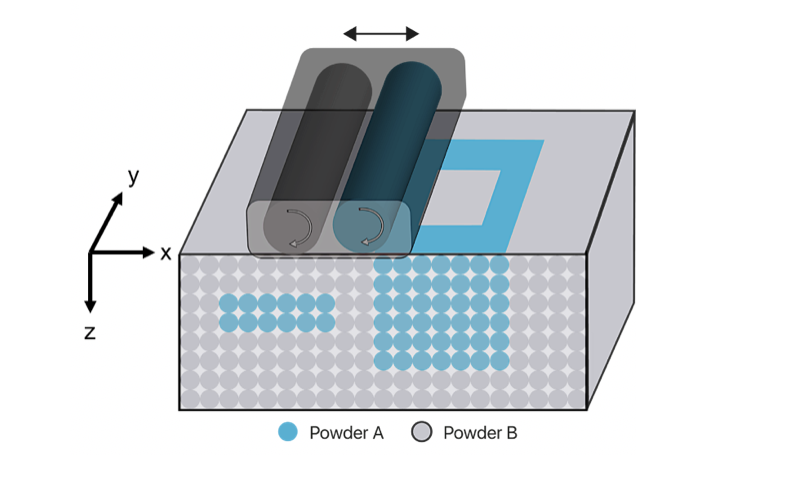
What do you mean with multi-material?
We mean, quite literally, more than one material. Our system can pattern two or more powdered materials side by side. Of course, sintering them together is an altogether different matter, and we cannot circumvent fundamental physical limitations. Therefore, two polymers or two metals with similar thermal processing temperatures can realistically be incorporated into a single part using the Aerosint powder deposition system to structure the constituent powders prior to sintering.
There’s also a possibility of making what we call “pseudo multi-material” parts. These would be parts in which the bulk of the part is a base polymer, and certain regions include composite materials composed of the same base polymer with an additive, such as glass fiber, carbon fiber, or even nanoparticles to locally enhance the part’s mechanical, electrical, or magnetic properties.
Recently we’ve demonstrated the co-deposition and sintering of flexible TPU with rigid polystyrene (left) as well as multiple colors of TPU (right).
Can you do gradient materials as well? Gradient and multiple materials at the same time?
You can think of the powder images we create as physical versions of binary (i.e. black and white) images. So, while we can’t pattern truly continuous gradients we can do dithered ‘digital’ gradients to form interfaces between two materials (see above, left). In our system, theoretically, you can pattern as many materials as you have rotating drums. In practice, there is, of course, a limit based on the machine size but 2, 3, or 4 drums per machine could be realized.
How can this be used to optimize surfaces?
Surfaces can be optimized in terms of material properties and material savings. One useful application is to be able to create parts that have a hard surface material to resist wear and abrasion combined with a tough inner material to resist brittle fracture (left). This strategy is even more attractive if the cost of the surface material is high relative to the bulk material. In another example, a copper part with high thermal conductivity can be made stronger and more resistant to stress with a steel surface (right).
What are the advantages of this (relative to other AM techniques)?
The most mature multi-material 3D printing processes are dependent on the curing of multiple expensive polymer resins, sometimes containing nanoparticles (as is the case for conductive resins). These resins are often quite expensive, and they tend to age and become brittle after printing. Because of these and other disadvantages, this resin jetting and curing process is better suited for prototyping rather than production-scale AM.
Powder bed AM processes have proven to be the fastest, most cost-effective, and scalable of all the various AM methods. We wanted to develop a process that builds on existing powder bed technology to make it able to process multiple materials. Our powder deposition system is also material-agnostic — we can handle polymer, ceramic, and many metal powders.
What are the cost advantages of your technology compared to SLS?
SLS of polymers is rather wasteful because unfused powder that has undergone an hours-long heated build process changes chemically in ways that prohibit its direct re-use in a subsequent build. Some amount can be reused when mixed with virgin powder, but there is almost always an amount which is thrown away.
The problem is worse for high sintering temperature materials, such as PEEK and other high-performance thermoplastics. It happens that these materials are also quite expensive to begin with, so any powder savings translates to significant cost savings. Our system allows for the deposition of expensive build powders only where needed, because a cheap, non-fusing support powder (such as ceramic) can be co-deposited in each layer.
By using ceramic powders as reusable support how much money would I save?
With conservative assumptions for build density and powder refresh rate based on data provided to us by a major service bureau, we estimate that the value of material wasted in a full build of PEEK powder printed in an EOS P800 system is about 32,000 USD. After only 38 full builds, the cost of powder waste would exceed the cost of the EOS P800 machine itself!
For PA12 and similar conservative assumptions, for a full build in an EOS P760 system the powder waste cost amounts to nearly 3,000 USD.
With an Aerosint recoater depositing both non-fusing ceramic support powder and polymer build powder, we believe the powder waste rate could be reduced to less than 1% of the overall amount of powder input in the process. For PEEK this represents less than 500 USD/build, or a savings of over 31,500 USD savings per build. In the case of PA12 the waste would be reduced to 74 USD/build, corresponding to a savings of 2,926 USD/build. Considering the hundreds of builds a major service bureau would do per year per machine, the cumulative savings can easily amount to millions of dollars per year.
A more detailed analysis is here.
What materials are you working on?
For the multi-material case, we have active projects to combine flexible and rigid polymers like TPU and PA12, multi-colored polymers, and steel and copper. For the powder savings case we are focused almost exclusively on PEEK, and we’re developing a powder deposition system that will withstand the extreme operating conditions needed for PEEK SLS.
I don’t see how you could use this to combine 3D printing circuits and polymers in one step. Won’t you melt or deform the polymer?
For circuits, indeed an approach cleverer than simply melting copper and polymer side by side is needed since bulk copper has a much higher melting temperature than any thermoplastic. We know of some interesting work being done to develop sinterable polymer composite materials that can be made selectively conductive in a post-processing step. As long as the matrix polymer of the conductive precursor material has a similar melting temperature as the surrounding bulk material, it should be possible to print conductive paths and insulating material at once using our system.
What kind of metals can you combine with each other?
Our first efforts are focused on steel and copper. With the same prototype system other metal-metal combinations should eventually be possible to validate.
How mature is your technology?
Our technology is maturing quickly but many aspects still need to be validated. In particular we need to combine our powder deposition expertise with the materials processing expertise of others to push our technology closer to the market.
What kind of partners are you looking for, and why should they work with you?
Our technology should enable multi-material AM, but we have limited in-house experience and resources to explore the space of material combinations that might be possible. We’re interested in working with research institutions and especially R&D departments of companies that have identified a need for multi-material additive manufacturing for improving their products and market position.
We’ll have a booth next week at Formnext in Frankfurt among the other startup challenge winners, and we welcome anyone to stop by to discuss applications and collaboration possibilities.


